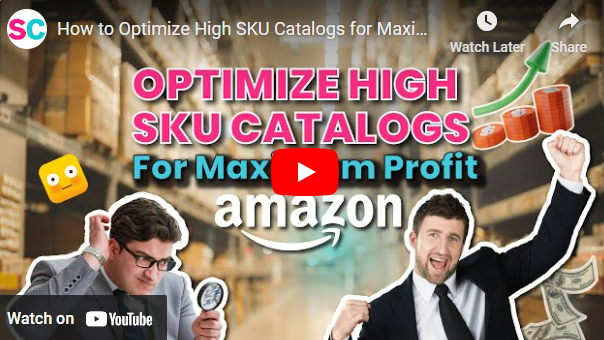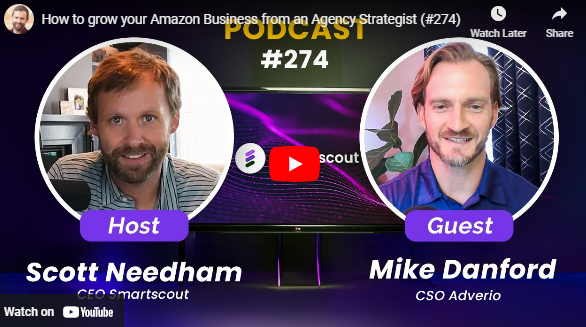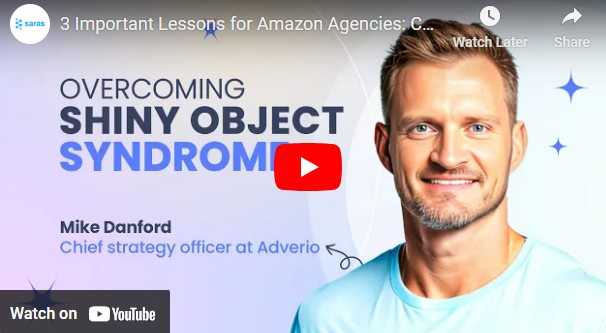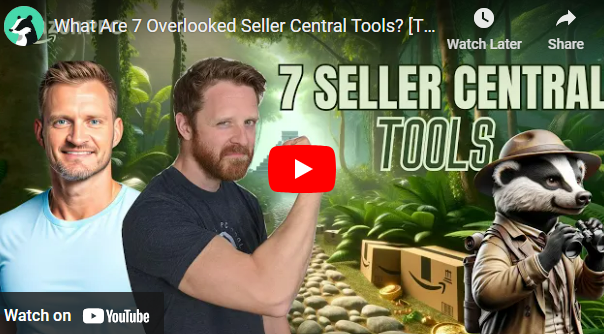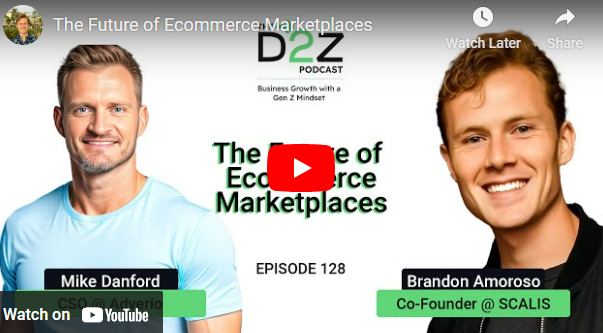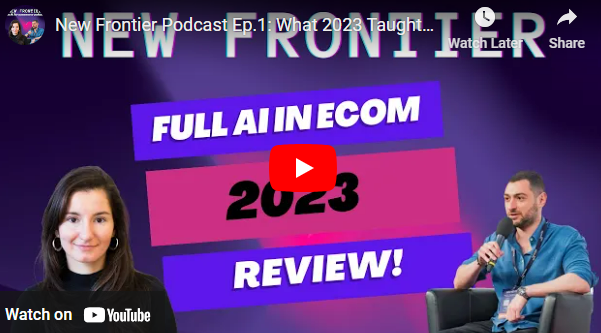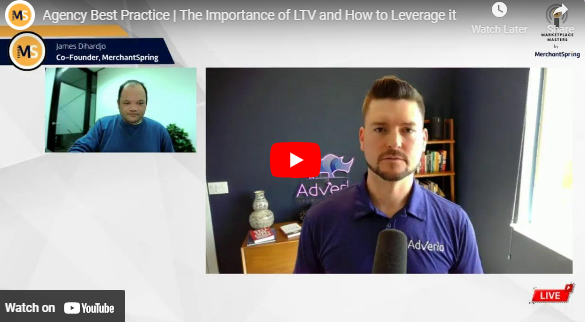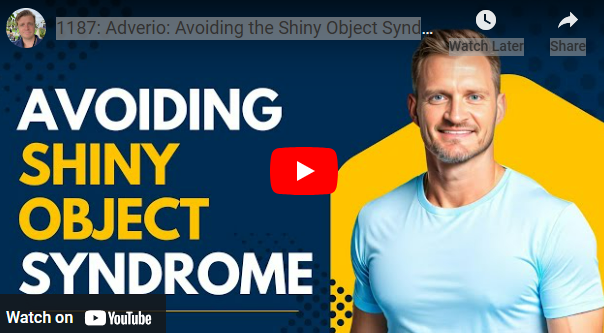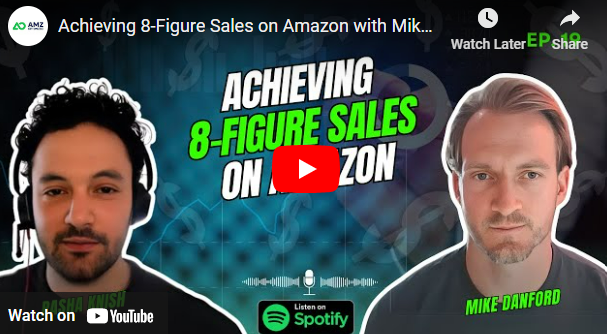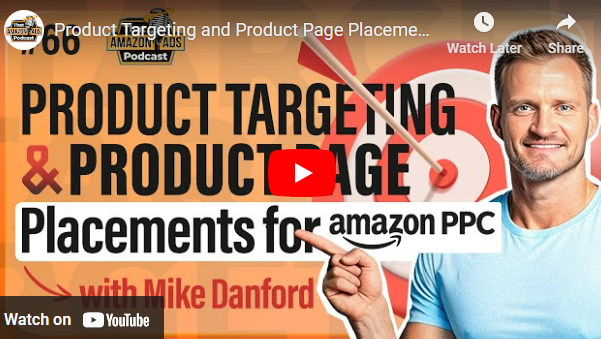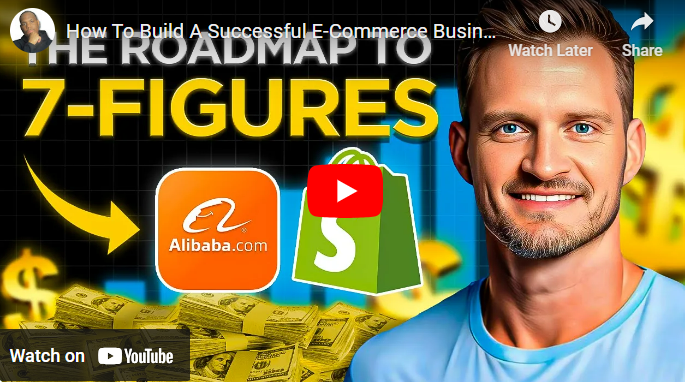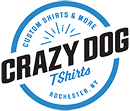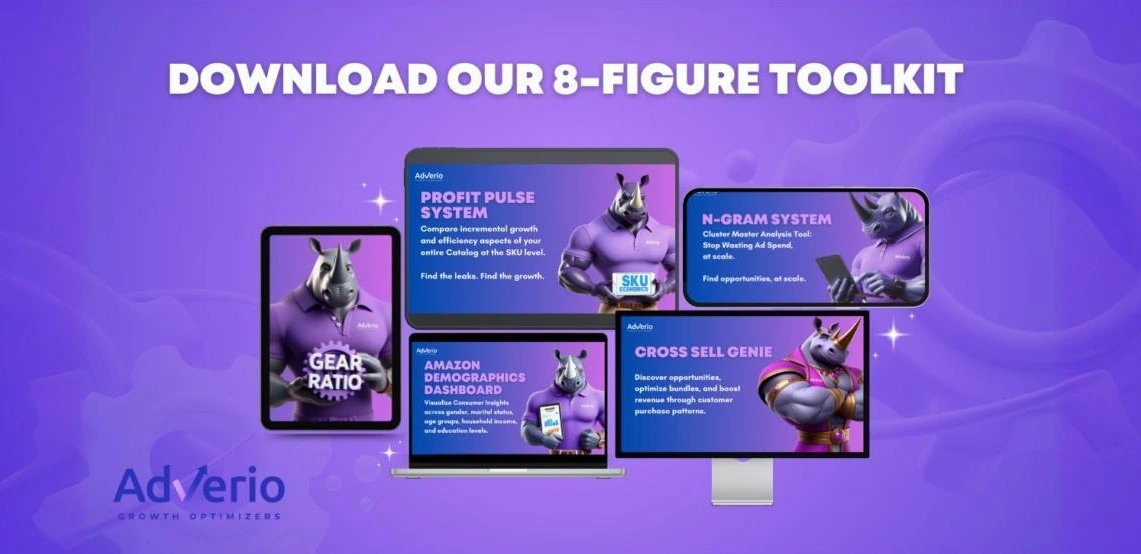Saras Analytics
The eCommerce Analytics Show
In this in-depth episode, Krishna from CGHRS chats with Mike Danford, Adverio’s Chief Strategy Officer, about the evolution of Amazon’s advertising ecosystem over the last decade. They dive deep into the significance of data in strategizing ad campaigns, the dynamic changes Amazon has made to its platform, and the impact of new tools and features on sellers and vendors. Mike shares his journey from being a seller to running an advertising agency, highlights the complexities of large catalog management, and discusses the importance of understanding why things happen through data analysis. The discussion also covers the roles of AI and machine learning in optimizing ad strategies and the future of data-driven decision-making on Amazon.
What this podcast covers :
- 00:04 Understanding data’s limitations enhances Amazon advertising strategies.
- 02:50 Amazon is becoming more open with data, enhancing ad strategies.
- 08:04 Custom solutions evolve from basic tools to advanced data analysis.
- 10:48 Agencies must customize workflows and data analysis for each brand’s unique needs.
- 16:04 Effective data utilization enhances internal discussions and performance analysis.
- 18:39 Utilizing data insights for proactive trend management in Amazon agencies.
- 23:21 Build custom tools to streamline processes and provide value to clients.
- 26:12 Balancing agency growth with the need for internal resources.
- 31:30 Empower teams through collaboration and data-driven autonomy.
- 34:00 Balancing experience and training in agency hires is essential for success.
- 39:04 Understanding year-over-year performance and leveraging generative AI is essential for growth.
- 41:29 Embrace AI for efficient data management and analysis on Amazon.
- 46:24 Standardization assists brands in gaining success on Amazon.
Mike Danford: [00:00:00] Mike, I don’t know whether this will go on the podcast or not, but I’ll ask anyway. Data only tells you what’s happened. It doesn’t tell you, a lot of times it can’t tell you why. Being able to answer the why behind the what’s happening and understanding why things worked or didn’t work and communicating that and creating that expectation to the brand.
And that’s a dynamic process.
Krishna Poda: Is it fair to say that you’ve been working on Amazon ecosystem for about 10, 15 years? I was a part of a project they are trying to build. Hey everyone, this is Krishna here. Co founder of CGHRS, and over here, I oversee our product and And data teams. And I have with me, Mike Mike’s from my video, Mike, I’m super excited.
This is my second time getting on a podcast and trying to record it. I’m always excited talking to folks like yourself. To me, this is an opportunity to learn and also to share that learning with the rest of the audience as well. So I’m hoping to have a great conversation today that will add value to me, hopefully to you and also to the audience that is listening to us.
Mike, do you want to give a quick introduction?
Mike Danford: Yeah, sure. Mike Danford [00:01:00] here, CSO or chief strategy officer for Vario. Been in the space since 2010. Started out as a seller doing some art to arbitrage, reselling Nikes, et cetera. And then just through that, one of my most expensive hires, whenever I started doing private label was advertising, realized it was numbers.
I was like, Hey, I like numbers. I can figure this out. So I started doing it for myself. And then at that time, a lot of Facebook groups were up posting results. And others were asking if I would help them out and they were willing to pay for it. And so the advertising agency is the history from there.
Krishna Poda: Interesting. So is it fair to say that you’ve been working on Amazon ecosystem for about 10, 15 years now?
Mike Danford: Yeah, since late 2014, early 2015.
Krishna Poda: Interesting. And how would you, if you were to quickly run through your journey from then to now in terms of your perspective? How you think about running advertising on on Amazon, and especially now with Amazon ramping up its ad products and launching new features every [00:02:00] day.
Anything that you can touch on how life was back then to Absolutely
Mike Danford: Much simpler and much cheaper in terms of clicks, 10 years ago obviously they’ve developed, which has been great. They’re definitely given us more data than they used to. Which is also great as well.
Lots more love, a lot more leverage to pull and, it’s hard not to have shiny object syndrome because of the rate, the release things and and obviously AMC makes it even more complex and is it, is the juice work, the squeeze, et cetera, but I love where they’re heading. It does seem like they’re investing more in that obviously want to know what they can do with some seller support.
It’s always the lag, but as far as that it’s definitely a more interesting platform. A lot more creative. You can get more copy involved, different types of ad placements, et cetera. So excited to see that.
Krishna Poda: Interesting. My observation. I’d love to hear your thoughts also on this is from the time and agents just see to go the roles at Amazon.
I see that Amazon has been a lot more open with respect to the data that they’re sharing. Do you see that data having a big [00:03:00] unlock for you at Adverio?
Mike Danford: Absolutely. Certainly, some of the back end data they’ll give, at the product and keyword level and different things, they’re opening up even more in the API, allowing us to do more data.
Lots of things that have been around for a while in platform. You can actually now export you don’t have to do bots or scrapes, yourself, et cetera. So I definitely agree with that. And, I think they’re still figuring out what to do with it and what not to do, like I said it’s a lot more data in the last year or so than we’ve ever seen before.
Certainly with the one P data
Krishna Poda: for sure. Interesting. And do you see that same pattern on the advertising and the seller and vendor side as well, or how, what’s your read on it?
Mike Danford: I think one P is always the, their beta where they test and give different types of sets of data.
And then obviously I’ll push it out to the three P later. I think they’re just trying to figure out what data is important to us and doesn’t really harm them in terms of giving getting Rick giving away their competitive advantage, if you will. And then I think that Amazon wants to have more [00:04:00] of the data.
More data on their platform as always. And if, since day one, they’ve lost a lot of, the advertising optimization and going at the third parties and they’re trying to build their platform so you can stay on their platform more with a lot more automation, like Google was, so I think that’s where I see it going next. And I was a part of a project where they are trying to build a programmatic platform inside of sellers. I guess technically inside the advertising platform as well. So we’re definitely trying to bring more of that in house so they can keep that data there.
Krishna Poda: Interesting. Just taking a step back right now, we see that Amazon is pivoting towards being more open, being shared, sharing much more timely data we see with marketing stream, they’re giving intraday data to sellers with Amazon ads, the latency of data is getting much, much better. The coverage of APIs that they are providing is also much broader than it was the case before, both on the Amazon.
Ads seller and on the window front. So from your perspective, as someone [00:05:00] running strategy at an Amazon agency, how do you think about data and its impact on the business and the decisions?
Mike Danford: Yeah, at first it’s again, trying not to get over inundated, not had that shiny object syndrome when they release something, understanding, trying to understand what it is it valuable?
I’m trying to do it at scale. And that’s an advantage, with an agency or someone that sees multiple brands, platform products, et cetera, it’s you can compare that and see what is of value. And it’s definitely a hard part. Sometimes you have to just do it. You have to just get in there, play around with it, see if it’s worth it.
And I feel like most brands really just need to focus on the basics. A lot of them are just trying to chase what’s being released and the new stuff. And they’re really failing on the basics. Both from the data. Incorporating the data and obviously how to leverage that data and read the data. We have brands come to us that, Hey, we want to AMC and et cetera, and I want to go through and I’m like, Hey, you’re only running sponsored products, not even doing brands, videos, DSP, sponsor display.
So there’s, the data is, it’s there, but what are you gonna be able to do with it? You’re not gonna really. It have a big impact on your tactics. I [00:06:00] think that’s the big thing to come across. And then, we work with large catalogs. So for us, a lot of, out of the box platforms are, they have the basics and they’ll give you the KPIs that everyone can communicate on, et cetera.
But if you really want to drill down and understand, what product to go after or what products are pulling or pushing or changing over time, that’s where we have to get into the custom solutions. And I think that’s. Definitely the hard part. I think brands in the beginning, smaller brands should just stick to a, an out of the box, something that’s simple, straightforward and does the heavy lifting for them.
And then, as they try to figure out what they are looking for, data sets they want to go after to, to come back that they’re competitive advantage or et cetera, then they can start going because it’s not just data that’s coming from Amazon. There’s a lot of 3P data out there. Obviously now with, getting to the reviews and there’s so many different data sources to come through.
So it’s what are you going to be able to, what can you access? What’s cost effective access? And then what can you leverage and use that data for? I think those are the questions that we have to commonly ask ourselves [00:07:00] over and over again.
Krishna Poda: I’m assuming that you didn’t end up at here. I want a custom solution on day one.
You talked about having a large catalog and you talked about, being able to analyze that last catalog, find opportunities and use those opportunities to drive growth. But in order to. Surface all of those insights. You also mentioned that there was a custom tool that you guys managed to build.
What I was saying was you probably didn’t end up with a custom solution right off the bat, and it was probably a journey and an investment over the years. So just walk us through that journey.
Mike Danford: Yeah, absolutely. So in the beginning it was, using Excel and VBA and local and then it’s being able to answer the why behind the what’s happening is where we really started to realize, Hey, we gotta dig deeper.
And a lot of data providers go after data that we feel isn’t as beneficial, [00:08:00] and it’s heavy and muddy. And then we have our own logic that this is how we would manually go and try to root cause analysis for a product, a keyword, group of products, whatever it may be. So we want to start building those in to where you actually already have that view.
As soon as you pop in, it’s, Hey, here’s what’s going on. You can get to the next level of questions from there. And now it’s, we talked about this, he’s trying to build in, more of the machine learning and AI pieces and getting NLP and all kinds of other aspects into it to be a little more intuitive and Hey, these are the 10 checkpoints.
Which one are we at? What’s going on? And then now it’s being more of proactive. Hey, we see a trend going this way. Favorable or unfavorable. Doesn’t matter. Let’s take a look at this. I think you guys call it like a watchdog alert, etcetera. Very similar to that against both sides, pros and cons to help understand like, Hey, if it’s going well, let’s do more of us pump gas on it.
If it’s not going well, hey, why is [00:09:00] it not? How do we fix it? And then obviously again, working with large catalogs that can get pretty noisy and busy. So it’s now it’s, Hey, how do we not make it too sensitive, but sensitive enough that we have a good reaction time to it. So it’s definitely, it definitely shifts.
And as I feel like there’s endless, it’s limitless. It never. Never be satisfied. There’s always something new and then, trying to do it at scale. And for us it’s just being able to see those trends across multiple brands, different sectors, categories, and even platforms as well.
And that helps us to understand what’s most beneficial at scale for all of our brands. And then we work with some, again, mid seven, mid eight figure brands. So very established to have their own piece. We’re trying to communicate with them. And then, their own could be on 10 different marketplaces.
So it’s, how do we bring all that data together? And again, reduce that noise. And again, it’s each brand is a little unique, but we try to build it as a, Hey, we’re doing it for one brand and it works really well. Let’s see if [00:10:00] we can do it for all the other brands as well. And that’s kinda how we, after we build it for one, how do we scale it?
And we also try to think about that while we’re building it as well.
Krishna Poda: Interesting. Is it fair to say that at an agency you have a point of view in how you want to analyze the brand and its performance on Amazon and your point of view then translates to a set of workflows. Those set of workflows might have a set of data points that are fueling those workflows and perhaps triggering certain actions to be taken by your team.
Is that, am I thinking about it correctly or because I’m assuming that every agency has their own secret sauce? And that secret sauce may or may not be encapsulated into a tool that gives you something right on the backs and you have to tweak a few levers here and there to get it. In a fashion that your teams can use, right?
So is that also a driving factor from a training your team perspective? And
Mike Danford: yeah, absolutely. It’s, I think it’s, if we’re running beta tests, we’re trying to understand data. We want to [00:11:00] have more of an internal view. First, want to filter that data. So there’s a lot of things that we report on internally that we don’t surface or expose externally.
Because again, trying to reduce the noise. For the brands for the end users, et cetera, that we’re reporting to especially during a trial phase or a beta phase or it’s really confusing. And it’s again, to your point, we have our own POV and we’re going, depending on what we are working on for the brand.
Some brands we work on, primarily just to marketing, advertising, intro platform. Others will go off the platform as well. And then others will go all across the platforms like a CMO role. And then some were on different platforms, different marketplaces, and we also get into the creatives and the copy and et cetera, and that really changes, the perspective as well as, Hey, we’re only looking at marketing, but we’ll also try to pull in other signals as well, such as pricing, optimization, inventory, management, et cetera.
And the more that we can pull in and share what the impact is up or downstream. I think that helps us. The brand also has their [00:12:00] POV and they’re looking at certain things and they have goals. We have some brands that are, they’re they’re backs, right? So that, so they have different pressure points and different timelines, et cetera, that are going after them.
We have others that have been around for decades and they’re a little more patient, so it’s navigating that. And then how do you build that view for them? It’s reduce that friction. For them. Hey, this is a report that we have internally report we give you. And then, hey, if they have to report to someone else, how can we help them do that and reduce that for them and paint that narrative for them?
So it’s definitely a collaborative process for sure.
Krishna Poda: Got it. Got it. With the solutions that you have currently in place, you have workflows that are. We’ve been to the solutions where you have your teams looking at the dashboards that you have when they started taking certain actions and then continue on, it would be great for me to get a perspective, both from an operational standpoint as well as from a executive standpoint in terms of how you’re leveraging data.
Mike Danford: Yeah. So we’re constantly trying to [00:13:00] standard our standardized, at least the core of our program. So we have what we call a GMAT broken growth marketing action plan. And historically that’s been disparate and separate from our reporting and KPIs. A lot of those questions can be answered through the reporting and the data that we have, at least in advertising and listing management side, so we’re trying to bring that in so that we can obviously see that and check those.
And it’s always trying to get that core. Internally, Hey, if you do these, this is like the burrito. If you do these 80% oh, I’m sorry to these, the 20 percent or whatever, and you’ll get 80 percent of what you’re looking for. And then it’s focusing on the rest and the more manual touch and trying to figure out how to get that extra incrementality for a product or group for products.
And again, it comes down to standardizing the core so that you can start, you can spend more time. And more of that human intelligence piece being brought in your experience and less of the machine reliance by going after those other things as well. And then reporting on those and having a nice try to have as clean of a testing bed, if you will for [00:14:00] whatever the metric or the tactic you’re going after a group of tactics, that’s obviously.
Part of it as well. And then the other piece for us, I think is to your point, is having it all integrated and being central. So we’re trying to build one central unit for that. And now we expose more of the operational node. Not just tactical and KPIs and metrics more of Hey, this is what we’re doing.
This is why we’re doing it. And this is what the impact is going to be and setting that expectation as opposed to just looking after the fact. Again, it’s a dynamic process. It’s not brands. Yes. Growth is great. But there’s also the soft skills of the communication and understanding why things worked or didn’t work and communicating that and creating that expectation to the brand and that’s a dynamic process.
Some folks just want to know more about the sauce, right? As opposed to just looking at the performance or when the performance is down, you got to explain that and teach that. And then it’s, the more questions we can answer for them, even outside of our scope, the better, and I feel like that’s part of it as well.
And we try to do that and [00:15:00] have those thought, thought leadership with them as well.
Krishna Poda: I’m single and internally from an agency standpoint do you use the tools that you have when you gather together as a team where you’re reviewing the metrics on the dashboards as a team as an executive team or from an operational standpoint where everybody has access to the same numbers and the discussions and debates on performance are more objective around results that have been driven versus being more subjective.
Any thoughts on that? On how flexible? The internal processes are, we’ve done all this.
Mike Danford: Yes, so internally, obviously, the objective is a lot easier with the data being there and standardizing that data so that you have a comparison across each brand that we work with, or each brand that the brand manager works with independently.
And then the teams will, the cross teams will have a cross function teams will meet, once or twice a week to talk about what they’re seeing and trends and what’s the impact of this because data only tells you what’s happened. It doesn’t tell you why it sounds can’t tell [00:16:00] you why. And if you don’t have those event markers on there, it’s very difficult because someone can spin their wheels trying to find out why did sales pop on this day or drop on this day or conversion changed or traffic spiked or whatever it may be.
Oh we ran a promotion or, hey, we changed the main image on this. Trying to. Tear down those silos as much as possible is definitely a large part of it. And then trying to tear down those external silos as well. Now we just switched over to a new project manager platform for that reason.
There’s Hey, we’re doing a lot of different things. We want to give you status updates if you want to. Yes, no. And it’s just like how much data, again, as I mentioned earlier. We have to work with the brands to understand how much data they care about and sculpt around that. Some brands are super data intensive and want to know more of, in the weeds.
Others are, no, hey, once a month is awesome for a checklist of what’s going on. And then if sales are down or whatever may be going down or didn’t work as expected, then obviously they want to know why ahead of time. And go from there, but it’s definitely dynamic. It’s different. Each personality it’s there’s cultures, there’s time zones there’s [00:17:00] different products.
It’s a lot, but it’s fun. And that’s definitely the fun part is trying to to do that. And I think it shapes us across the organization as well.
Krishna Poda: Is it fair to say then that your team and yourselves spend more time on investigating the why, because the what is taken care of quickly. So we are done as an example.
There is a trend. There are, let’s say, 20, 000 SKUs that you guys are managing. You spot a trend quickly across all of these SKUs. And then the discussion is more or the discussion is more around the why and the actions that need to be taken that rather than being able to spot it yourself.
Mike Danford: Yes, we try to have as much automation in the why.
Obviously, things will happen where it’s unexpected, something will again favorable or unfavorable happen. Yeah, then you’re going in, you’re trying to figure out why. And if you, if. Then we try to figure out, hey, we’re constantly having to ask this question or ask this why, and we, it’s a manual process at that point.
Then we’re like, hey, Can we build a view for that? Can we build a report for that? Can we build an alert? Can we be proactive [00:18:00] to it or at least reactive whenever it happens? Here’s the next 10 things we would check anyways. And here’s your report. Again, that’s where I’m trying, we’re trying to bring that machine learning, the AI and to do that dynamically and we can only as humans digest certain number of data points and again, working with large catalogs, it can see more trends or at least different trends, whether they matter or not, we’re trying to figure that out as well.
But I would say, yeah, the why is definitely, we want to know why, so we can either replicate or not do it again, right? Hedge it in the future. And then that’s what the brand is going to ask. That’s the next question we’re going to ask. Why did we go up? Why did we go down? Why are we doing this?
Why are we not doing that? I feel like that’s yeah. It’s the five whys of it, it’s like why to get down to the core. So
Krishna Poda: definitely, and that’s where, so in your case, you have your own data warehouse with data piping into your data warehouse in a consolidated manner. So is it fair to say then that because you have your own data warehouse with data from all of the different brands, Consolidated into a single place.
It gives you a lot more control in terms of [00:19:00] instrumenting some of these alerting so that let’s say there is a event that happened is unexpected or undesirable. Then you have some proactive measures implemented in the data, some sort of alerting setup, custom alerting setup so that the next time you catch it earlier and stop the leak.
Rather than dealing with the dot profile.
Mike Danford: Yeah, I think going back to your, one of your other questions, why did we go from out of the box to a custom and part of it was trying to get more of the why and we couldn’t do it inside the box. And then the other is the pure volume of data that we have, it’s expensive when we go to out of the box solutions, they charge by product ASIN number of whatever it may be, and that just doesn’t work for us.
And then to your point, the next layer is. Hey we brands have really specific questions. We need to be able to build something custom for them to answer themselves, as opposed to having to come to our brand managers or like I said, having that report for someone else, internally or externally, depending on what they’re trying to do.
And it’s really difficult to [00:20:00] do that in a, I, a standard solution, if you will. And it’s also being able to, to your point is that control is, What’s going on, being ahead of it and but with that it becomes, there’s issues, right? There’s data management is larger, a lot more technical team, software engineers, technical engineers, data scientists that come with that.
And that’s fun for me. That’s what I like as well. So that’s part of why we have that. As well as to be able to have that control and allow me to have a little sandbox.
Krishna Poda: You actually brought me to my next question, actually. How do you think about having a data team at an agency? Because. Is it, do you look at it as a cost of doing business?
Do you look at it as a, we look at data as the highest ROI channel. So that’s how we look at it. But it would be interesting to see how, from an agency’s perspective, you think about your data team. It could be a one person team or it could be a bigger team, but we’d love to get your perspectives on it.
Mike Danford: Yeah, I think it’s definitely changing and it’s something that we Sometimes we’re [00:21:00] pretty in tune with and other times like, Hey, will, what are we doing here? Why are we doing it? And let’s try to have a quarterly or a semi-annual recalibration, if you will. And I think there was a question, more about what’s the first, or your order, for us it’s data scientists.
It’s, let’s have the data and manipulate it and play around with it in a static environment and build a lightweight. Report or solution to understand what that is. We can be more nimble and fast. And then if it makes sense and Hey, this works really great for this brand, the brand love the output.
Now let’s come back to our more sophisticated team, obviously your team, and let’s figure out how to do this more automated and systematic and at scale. Across all the accounts. I think that’s the process for us. And, now I have a dedicated data scientist that’s assigned to me. Specifically me, all my projects, which is awesome.
It keeps me out of Google sheets. I still learn. And then, for us, we build these one off tools are in a really valuable for us. And then we give those out for free to the folks that visit our website and interact with us because we know the value that’s there. And everybody, [00:22:00] for the most part, everybody has a very similar question for that, or if they’re on different platforms, et cetera.
So that’s also fun is to be able to give that back. And so it’s not a truly sunk cost for us. It’s a lighter weight. It’s a more nimble solution for brands that don’t have the, massive data pipelines and et cetera. They can pull a static report, don’t need it to be automated at scale across dozens and dozens of brands.
In terms
Krishna Poda: of the teams itself, Mike, I know you do a lot of heavy lifting at Video in terms of the ideation on what you want to have implemented, what you want to see. What is important, what is not important, so on and so forth. When we go to the really big agencies, they have a dedicated technical team, data team.
Sometimes software engineers are hired and they’re doing data engineering work. Sometimes there’s a dedicated data team itself. And sometimes we see A single person data team that’s in charge of setting up the pipelines, automating every dashboard, so on and so forth, right? At what point in time [00:23:00] does hiring a team internally versus having a team manage that infrastructure for you?
Make sure it is up and running. Makes sense. Does it make sense for an agency to have? Let’s say as an agency that’s managing less than a hundred brands, does it make sense to have a, an internal data team versus to have a team fully manage that for you? What’s your perspective on it?
Mike Danford: That’s a great question.
We, we had that ourself and we went, we have full circle. So we had basically a quasi or semi internal team. And what our hurdle is, we are on multiple platforms. So you have Amazon, Walmart, target, Google. And then Shopify and some other platforms pulling in and, just like the advertising on those platforms for the most part is unique and different.
The code, the platform, the APIs to process the data is different as well. And we basically had one person, basically like a CTO fractional CTO for us. [00:24:00] It’s just overwhelming and it’s difficult to keep up with all of those if you’re the main source and you have to have a dedicated specialist and a person for each platform and each code to understand that.
And that’s where we come to all because it allows us to do that at scale. It allows us to understand what is going on. We can build IP on top of what you have, which is very helpful for us to keep some of that logic, etc. But we get that security for us right now that there’s you also see other agencies and other providers as well.
So we’re leveraging your data and your mindset as well and scalability for us. And for now, it works for us. I don’t know. I don’t know if it’s a number. I don’t know if it’s a, I would assume it’s a dollar dollars and cents, right? Once it makes sense. But I also, I like having a deeper bench. I think it’s a big part for us, it becomes an HR role whenever we hire internally and who’s going to do that. And then I think it’s the credibility. I think it’s obviously, I like having, to my point is having more people involved and asking those questions. Hey, what [00:25:00] else are you seeing? Or having those strategic partners, just like we would, if for our brands so I don’t know, we’ve never really thought about when we’ll go.
If, or when would we come back internally? I think that, it’s pretty significant. Scale from where we are right now to do that, just because I like how it works. You have a lot of out of the box things that are built and we can just expand on that where we would, we had to start from scratch every time we have a new idea, it’s starting over.
So I think that your speed to launch and speed to creating new views is much faster than if we were in house. And for now we, we like the being nimble. And if that’s, if we’ve got to pay a little more for that’s okay. Just because of where we’re at, it’s changing so fast. Yeah, I don’t know.
I don’t have a good answer for that. I think that for us, it was, there was a certain number of accounts and it really, it was about the consistency of the data and the frequency of the data was a big part for us to go from a simple solution to a more custom solution. And then, to your point, I’m just trying to think, I don’t have an answer.
I don’t know when we would go [00:26:00] internal for now. I just keep doing great work. And we’ll see. For the long haul, right? Yeah.
Krishna Poda: No, great. A great answer. The reason I asked that question is because I asked my question that myself as a. Tool provider and as a data team provider for us also, it’s a constant question of especially from the agency side of the house to what level of engagement from our standpoint is good at what point in time do we price ourselves out or at what point in time do we stop adding value to an agency, right?
So those questions keep lingering. So that’s where I’m coming from. And one of the other questions I wanted to ask you as a follow up to what you just mentioned is, what kind of risk does attrition in the data team slash the tech team? Post to the initiatives that you might be undertaking in house.
Yeah, for now, we don’t
Mike Danford: have that. I think we’ve broken it up enough and going back to my other answer is, that’s why we have you all with a deeper bench to where we don’t have to deal with that. We [00:27:00] don’t have to scramble for that because we are relying on the data so much. We have our internal data science, Pretty easy to plug and play and expand and contract as we need for right now, it’s full expansion.
We haven’t really had to contract thankfully. So far, it’s not really a concern with us. It’s, and I think that’s largely because, you all can handle that for us and having that partnership in place to as we expand, you can expand and you are more tech savvy than we are in understanding what skill set, where to find this, the skills and the talent pool.
That’s not something we do on a regular basis. So we trust you guys for that as well. And I think it’s, how it works and that’s probably why we don’t have to think about that. So thanks.
Krishna Poda: No, understood. Mike, I don’t know whether this will go on the podcast or not, but I’ll ask anyway, internally we are a company that builds data solutions, but every now and then I come back thinking we are just not as data savvy as we want our customers to be, we need [00:28:00] to be more data centric because that makes discussions internally a lot more objective.
And that also meant that. The culture in the company is not just around giving insights and building data solutions for customers, but also should be ingrained in each individual within service. And that requires some amount of time and effort and investment of resources into making that transition happen.
Even if. Transition might be a strong word, but to keep improving in that area, right? We have to think about it right from the time of onboarding, reinforcing that in every single opportunity that we get. So from an agency perspective, when you’re looking for hiring people into the team. Or when you’re looking at improving the performance on a particular account, how do you how do you be objective and how do you drive that culture of being data driven at the agency?
I know you are, but from an agency level, how do you make sure that happens?
Mike Danford: [00:29:00] Part of it is to level that playing field as, as much as possible and making it where. The answering as many questions for whoever’s working on the brand, internal, external through automation and simplicity, and then giving them that freedom and the autonomy to look at the data their own ways and spin it up and collaborate.
Hey, a brand asked for this, and I really know where to find this or how I would do what I was thinking this. Do we have this? Yes, no. Okay. And no, then we dig into it and it gets put into our queue to, to bring in and see, Hey, are there other brands that could benefit from this? Yes. Then we incorporate it.
So it’s more about, giving them the freedom to ask the questions and to think and have that. And answering the core questions for them. So they don’t have to race their time and resources and energy on that. We do test for, data literacy, if you will do you know where to find this?
Do you understand what this is? There’s a couple of tests before you can get to communicate or submit your application with us. It’s pretty basics and our role is heavy [00:30:00] data centric and communicative. And then the other piece is, and I think this is, to what you’re speaking to is more consultative, it’s reporting a performance is great, pretty easy.
We can do that from a, technology stack that we have. And as I’m talking about trying to build more than automation, but the other is, what’s next? What is the data not telling us? Where else can we go that we haven’t told the data to look? What is a new features coming out, a new reports coming out?
What do we do with that? Should we do that? Should we not do that? So given them that freedom to, to communicate within themselves and obviously with the team. I think that’s the big part is the, and the culture of a collaborative culture and a, this. Our way or no way.
I think that we’re not like that. We want to have that collaborative input and because everybody thinks differently, everybody has different backgrounds, whether they’ve been another agency or they’ve been another marketplace or kind of fresh and just coming fresh out of a school or program that we’ve had for and been able to mold.
And I love that. We’ve just hired. I have [00:31:00] six new people in the last month that are supporting our advertising team, and most of them are a little more green to Amazon advertising specifically, and they have tons of questions, and they’re asking questions that we haven’t asked ourself in, years, right?
Oh, okay, this is something we forgot about. We can come back to doing that. And then obviously trying to answer as many of those internally so we can get them to accelerate. We are talking right now about, what, how much, I don’t say bad habits or good habits, but how much experience should they have?
What is the right blend of, experience and viewpoints from other, again, other agencies or wherever they worked previously, or do we want someone that’s brand new. We can mold and shape them to your point. That’s, it’s hard to work. It’s a longer timeline.
And then, we’re pretty impactful on their career and developing their career. So it’s definitely a balance, for us working with again, larger brands, mid seven, mid eight figure established brands. We do have to have a certain level of seniority to be able to communicate to the brands.
And that can be expensive for us. It can be expensive for the brands. Yeah. And we’re trying to figure that out to understand what is that right [00:32:00] mix from day one to your point, it’s bring them in. So now we’re trying to bring them in behind the scenes for longer than we used to.
We used to release them out to the customer faster than maybe we should have. I’m not really sure if it’s a, we haven’t figured that part out. But we want to give them that confidence, right? Before they have the pressure from the brand. Because, nobody likes a disgruntled brand or customer asking questions and the brand manager can’t answer those questions.
So we want to give them that confidence first. I think that’s been huge for us is. Run a mock internally is hey, there’s five or six questions that brands are going to ask that I would want to ask you if you’re reporting to me on that and just running through those trials as well.
And that’s a longer answer, but it’s how we think about as well as little soft skills, soft side.
Krishna Poda: Thank you for that. Wrapping up from a personal insight standpoint, what. Advise what you give agencies that are thinking about their own data stack because there are many things, right?
The technology selection, the team selection, whether when I say [00:33:00] team, it’s either hiring internally or it’s finding a vendor that can support you. The cost is a big factor as well. How much customization do you need to have? Because there’s no end to how much customizations one can do on a data initiative, right?
So what advice would you give someone who is considering having their own data stack?
Mike Danford: That’s a loaded question. And I think when we get back to, as I mentioned earlier, we found how to be nimble and also be able to scale. So it, what it really boils down to is, we got a new view or data sets or pipeline, whatever it may be that we’re looking at.
And then at first we just try to do it static. And then the question we ask ourself is how often do we need to report on this? How often do we need to think about this? Obviously our brands have at least one monthly touch point from a, end of month reporting perspective. Is that enough?
Or does it need to be weekly? Does it need to be daily? Does it need to be intraday? Does it need to be more sophisticated, more [00:34:00] detailed? Is it just a report? Is it just statistics? Is it, is there also questions? And, I think that’s the big thing for us is a cadence and then the complexity of it, how many different depends on, for us, we have multiple different data sources, different platforms, and we have to aggregate and pull it together.
And it makes, that adds complexity to it really quickly. When you’re pulling in different things and then the next layer is how large is that data you’re pulling? Is it, and then, one thing that I’ve had to learn and realize that. Is the, how dirty is the data? How commingled is the data?
Each platform is very unique in that. And then what we found out is instead of having to try to decipher and scrub and clean the data later, it’s how can we do it on the front end with the way that we set up our campaign structure or our ad groups, or the way our naming conventions to make the data that much easier to report on, we’re just working with your team.
I think yesterday, I guess earlier today and there’s a naming convention that’s inside of the product. And then [00:35:00] there’s a product category node. And this makes the, it cleans the data so fast as opposed to trying to figure out a super complex way of splitting the data, mirroring the data and bringing it back and.
I think that’s a mess of questions that we asked, and again, I think it’s I think cadence is definitely number one. And then and then the size of data, the amount of the data, the cadence
Krishna Poda: can change. You might start off working with a customer on a monthly cadence call, and then it might quickly.
Growing to a weekly cadence call and now suddenly I’m assuming your brand marketers are spending time preparing for that meeting a couple of hours every week. And that can be quite productive, I assume.
Mike Danford: Yeah, absolutely. And, one thing that we found out I have a little bit of a trading background and, looking at moving averages was pretty impactful.
Whether it be 180, like a large moving average versus a monthly versus a weekly. And, what we realized is that smoothing the data over a seven day moving average has been really impactful for us and not [00:36:00] being knee jerk and the brands realizing, Hey, it’s a week, let’s see a couple of days down a couple of days up and it kind of flaps and levels out at the week and then the second part is.
Year over year, we’re always trying to look at year over year. A lot of brands in our history, historically month over month. And I know that some of the more larger brands have been in space for longer. We’ll know Hey, this is a slow time of year. This is a high time of year. But the hard part is looking at the product level year over year.
And we’re working, we’re obviously working that right now. A lot of brands that we have the data for that we’ve been working with for years. It makes it easy, but. When you connect a new brand, you’re most of the platforms, you can only go back at least some advertising or some of the data only can go back granular for the products at 60 or 90 days.
So it makes it hard to do a year over year. It takes 10 months before you can do a year over year. So now it’s trying to work on that as well. I got a little bit of a tangent on there, but that’s just it’s, there’s so many tangents to this, right? So many different ways you can look at this stuff.
Krishna Poda: Got it. Got it. Lastly you’ve been excited about generative AI. And there is [00:37:00] recent news that people can buy on TikTok and get products delivered by Amazon. I don’t know, in India TikTok is banned but in the U. S. I don’t know if that feature is live yet. I’m assuming that would For some changes to your data stack, if some of your brands are leveraging that functionality, but anything with the recent technical trends that you’re very excited about?
Mike Danford: Yes and no. One, yeah, the platform and it’s fairly recently released and they don’t, they, Amazon and TikTok haven’t figured out their attribution. It’s really difficult when you use a link in the back end. And once it comes from TikTok over to Amazon, you lose it. So you don’t really know what’s going on.
But, I think it was Bezos actually that, one of his early mantras and comments, it was, Hey, a lot of people are focused on the train and what’s next. And he really wanted to focus on what’s going to be here forever or for the next 10 years.
What’s not going somewhere. Let’s build on that. So to that point, AI is going to be here. It’s how do we build that AI? How do we scale that AI? And how do we, how are we able to bolt on and off [00:38:00] the new things that are coming quickly? As opposed to trying to do everything at once or looking at everything.
It’s like I’ve mentioned earlier, it’s Hey, we have a large data sets. How can we increase the efficiency of managing the data set? How can we increase the efficiency of analyzing the data set? And then how can the data, the machine. Give us a different perspective, give us a different point of view.
I’m really, that we can either train the model or untrain the model and kind of ask questions to it and interact with it as a more conversational tone to make it easier for the entire team to train. And that’s what GPT did was, Hey, let’s have some communication. And get some semantics involved.
And how do you ask questions and think about things? Because the machine was trained by, a certain team, right? And certain different semantics or certain set of semantics. To that, if you’re not getting involved in AI, at least staying in tune with what it is and thinking about how to integrate it, you’ll get left behind.
We’re already there. You’re seeing, Amazon’s pushing out, automatic updates to the copy. I think it goes live in two or three days to where if you’re using emojis and other things in your copy, it’s going to automatically update and [00:39:00] change, as a big shift from keywords.
Yes. Keywords are still important. There’s more of a conversational and answering, situational questions. How would I use this product like a lifestyle question? And then your images, a lot of brands have not really focused on images. Historically, they’ll sling up product and a couple of simple images.
But now people are, very visually stimulated and have questions. And if you have quality visual content, one, it helps the shopper answer questions faster. The second is now they’re scraping the images and they’re incorporating that into that. And it’s getting indexed based on what is or is not in the image.
So the more, you can answer in that, I think that’s where we are going now. We’ve been playing around with Amazon recognition for a little while. What is it? Scrape? What’s the capacity? And how does Amazon take that into consideration? So That’s our more recent shiny object, if you will.
Krishna Poda: Interesting. I’m assuming with now with the AI stuff, the pace of change on Amazon will also probably increase. Maybe the listing might, new images [00:40:00] might be added, let’s say once a week as opposed to once in a month.
Mike Danford: Yeah.
Krishna Poda: The content on the listing might change more frequently depending on what the algorithms are learning.
And therefore, I would also assume that the analysis might end up being a lot more frequent as well as the numbers move up and down more frequently. And I’m sure you’re well positioned to adjust to that that pace of change. Yeah.
Mike Danford: Yeah. I’m actually excited about that.
I think it takes a little bit of the advantage away from us, at least on certain aspects. A lot of brands will come and they’re not dynamically testing copy or images or pricing or anything. And now Amazon is like, Hey, We have a lot of data and we think you should add this image or add this to your image.
We’ve given you some recommendations in the past and you still haven’t added it. Guess what? Now we’re going to do it. So I think that’s what’s happened is Amazon says a lot more data than we can. Obviously they only give us a small sliver of that. And they’re basically saying, Hey we see a lot of brands that I think, Amazon’s goal is to make money, right?
So if they see an opportunity to increase the conversion, [00:41:00] increase the click through rate, and push a product a certain direction, and they think they can help the seller, they’re going to do that. And then the other side is, I don’t want them to control my listings. They’re going to, they’re going to, jack it up and they will, things are going to happen.
They’ve been messing up listings since they started. We’ll get delisted or whatever for random reasons, or they’ll tag a category in the wrong, like a hazard policy and pull all the products down and it’s a whole mess. I do think that will have a little more uniform and uniformity and standardization of the shopping and customer experience on the platform.
Just like Google doing updates to its SERP and some other things and getting away from the stuffing and in the cramming because Walmart has pretty much since day one has been pretty strict on their qualities, listen, quality score and style guides by category, basically it’s, brand product feature this and that’s it.
You can’t stuff it. You can’t, it’s very simple and clean. It’s got to focus on the images. And get them to click through the product and [00:42:00] then you can start to educate them and guide them And I think amazon is taking I honestly think they’re taking a little bit of a page out of walmart’s book for that target as well a little more standardized.
So I like where it’s going, you know they’ve been sitting on the data. It’s a massive report. Their cosmo report is pretty long It’s insightful. And I think the big thing from that report was I can’t i’m not i’m gonna butcher this it’s a it’s a Sliver of a percentage that they could increase their revenue as a result of this.
And that across billions of dollars is a really big lift. And the cost to implement that, they’re like, we already have the data. Why don’t we just implement it and make more money? Can’t blame them for it. And then, I think again, it’s just standardization. I like that. I do that for a platform and creating that shopper experience and helping.
Brands that are just getting started and don’t really know what’s going on and don’t have the wherewithal or the capital to invest in someone that knows how to do it on the platform is and they sling something up and they don’t have success. I think we’ll have newer products [00:43:00] doing better than they used to.
I think that we’ll have newer products not doing as good as they used to. You can’t hack the system. It’s it’d be interesting. For sure. And we’re just at the beginning of it, very early curve.
Krishna Poda: Absolutely. We are excited about the the trend on the AI front for sure.
And I’m hoping we can unlock a few things for you along the way as well, Mike. So thanks a lot for for the insight. It was lovely chatting with you. For those who are listening to the video, Mike if someone wants to reach out to you, if a brand wants to reach out to you how would they get in touch?
Mike Danford: Absolutely. Thanks for having me. So obviously on LinkedIn, but more directly, we have a, an eight figure toolkit. Again, those tools I mentioned earlier that we’ve built the one off tools and we give them to the folks that come to our webpage, obviously your listeners going to have access to that. It’s just at vario.
io forward slash podcast. And the resource will be sitting there for you. You can obviously go to our download resources section as well. That’s another way to get ahold of it. Look forward to connecting and revisiting in the future. Awesome. Thank you. Lovely chatting with you.
Krishna Poda: Hope to talk to you soon.
Mike Danford: We’re [00:44:00]
Krishna Poda: done.
Mike Danford: Yes.
Krishna Poda: All right. So
Mike Danford: much Mike for your time.
Krishna Poda: Mike, thank you. Yeah, no worries.


